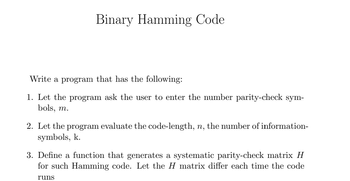
Database System Concepts
7th Edition
ISBN: 9780078022159
Author: Abraham Silberschatz Professor, Henry F. Korth, S. Sudarshan
Publisher: McGraw-Hill Education
expand_more
expand_more
format_list_bulleted
Question
Please give me the justified solution
Note:
1. Don't use LLMs
2. H matrix should differ each time you run the code
3. Consider the general form of the parity matrix so identify matrix is fixed

Transcribed Image Text:Binary Hamming Code
Write a program that has the following:
1. Let the program ask the user to enter the number parity-check sym-
bols, m.
2. Let the program evaluate the code-length, n, the number of information-
symbols, k.
3. Define a function that generates a systematic parity-check matrix H
for such Hamming code. Let the H matrix differ each time the code
runs
Expert Solution
This question has been solved!
Explore an expertly crafted, step-by-step solution for a thorough understanding of key concepts.
Step by stepSolved in 2 steps

Knowledge Booster
Similar questions
- I need help with my MATLAB code. I am using ode45 to solve my differential equation. But, the size of w_ode is 9x645. Size of t is also 1x645. How is that possible? Shouldn't t be 1x101 and w_ode be 9x101? How do I get the size to be 9x101? I need that size because I am subtract that matrix by another matrix of the same size. I_T = 2;J = 1.5;I = [I_T; I_T; J];w = [-0.1; 0.3; -1.1];L = [0;0;0]; t = 0:100; % Using ode45 to integrate w dotoptions = odeset('RelTol',1e-10,'AbsTol',1e-10);result = ode45(@dwdt_Bframe, t, [w; I; L], options); % Extracting information from ode solvert = result.xw_ode = result.y function dwdt = dwdt_Bframe(t, wIL) w = wIL(1:3); I = wIL(4:6); L = wIL(7:9); % The w dot equations dwdt = zeros(9,1); dwdt(1) = (-(I(3) - I(2))*w(2)*w(3) + L(1)) / I(1); dwdt(2) = (-(I(1) - I(3))*w(3)*w(1) + L(2)) / I(2); dwdt(3) = (-(I(2) - I(1))*w(1)*w(2) + L(3)) / I(3); % Keep the values of I and L constant dwdt(4:6) = 0; dwdt(7:9) = 0; endarrow_forwardUsing MATLAB, Create a 3-by-4 matrix containing values drawn from the uniform distribution from an interval between [0, 1].arrow_forwarddisplay the coefficient matrix A and the augmented matrix B for the given system. x1 − x2 = −1 x1 + x2 = 3arrow_forward
arrow_back_ios
arrow_forward_ios
Recommended textbooks for you
 Database System ConceptsComputer ScienceISBN:9780078022159Author:Abraham Silberschatz Professor, Henry F. Korth, S. SudarshanPublisher:McGraw-Hill Education
Database System ConceptsComputer ScienceISBN:9780078022159Author:Abraham Silberschatz Professor, Henry F. Korth, S. SudarshanPublisher:McGraw-Hill Education Starting Out with Python (4th Edition)Computer ScienceISBN:9780134444321Author:Tony GaddisPublisher:PEARSON
Starting Out with Python (4th Edition)Computer ScienceISBN:9780134444321Author:Tony GaddisPublisher:PEARSON Digital Fundamentals (11th Edition)Computer ScienceISBN:9780132737968Author:Thomas L. FloydPublisher:PEARSON
Digital Fundamentals (11th Edition)Computer ScienceISBN:9780132737968Author:Thomas L. FloydPublisher:PEARSON C How to Program (8th Edition)Computer ScienceISBN:9780133976892Author:Paul J. Deitel, Harvey DeitelPublisher:PEARSON
C How to Program (8th Edition)Computer ScienceISBN:9780133976892Author:Paul J. Deitel, Harvey DeitelPublisher:PEARSON Database Systems: Design, Implementation, & Manag...Computer ScienceISBN:9781337627900Author:Carlos Coronel, Steven MorrisPublisher:Cengage Learning
Database Systems: Design, Implementation, & Manag...Computer ScienceISBN:9781337627900Author:Carlos Coronel, Steven MorrisPublisher:Cengage Learning Programmable Logic ControllersComputer ScienceISBN:9780073373843Author:Frank D. PetruzellaPublisher:McGraw-Hill Education
Programmable Logic ControllersComputer ScienceISBN:9780073373843Author:Frank D. PetruzellaPublisher:McGraw-Hill Education

Database System Concepts
Computer Science
ISBN:9780078022159
Author:Abraham Silberschatz Professor, Henry F. Korth, S. Sudarshan
Publisher:McGraw-Hill Education

Starting Out with Python (4th Edition)
Computer Science
ISBN:9780134444321
Author:Tony Gaddis
Publisher:PEARSON

Digital Fundamentals (11th Edition)
Computer Science
ISBN:9780132737968
Author:Thomas L. Floyd
Publisher:PEARSON

C How to Program (8th Edition)
Computer Science
ISBN:9780133976892
Author:Paul J. Deitel, Harvey Deitel
Publisher:PEARSON

Database Systems: Design, Implementation, & Manag...
Computer Science
ISBN:9781337627900
Author:Carlos Coronel, Steven Morris
Publisher:Cengage Learning

Programmable Logic Controllers
Computer Science
ISBN:9780073373843
Author:Frank D. Petruzella
Publisher:McGraw-Hill Education